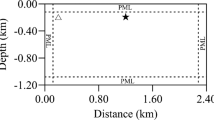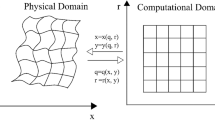Abstract
We apply the newly proposed double absorbing boundary condition (DABC) (Hagstrom et al., 2014) to solve the boundary reflection problem in seismic finite-difference (FD) modeling. In the DABC scheme, the local high-order absorbing boundary condition is used on two parallel artificial boundaries, and thus double absorption is achieved. Using the general 2D acoustic wave propagation equations as an example, we use the DABC in seismic FD modeling, and discuss the derivation and implementation steps in detail. Compared with the perfectly matched layer (PML), the complexity decreases, and the stability and flexibility improve. A homogeneous model and the SEG salt model are selected for numerical experiments. The results show that absorption using the DABC is considerably improved relative to the Clayton-Engquist boundary condition and nearly the same as that in the PML.
Similar content being viewed by others
References
Bécache, E., Givoli, D., and Hagstrom, T., 2010, Highorder absorbing boundary conditions for anisotropic and convective wave equations: Journal of Computational Physics, 229(4), 1099–1129.
Bérenger, J. P., 1994, A perfectly matched layer for the absorption of electromagnetic waves: Journal of Computational Physics, 114, 185–200.
Bécache, E., Fauqueux, S., and Joly, P., 2003, Stability of perfectly matched layers, group velocities and anisotropic waves: Journal of Computational Physics, 188(2), 399–433.
Cerjan, C., Kosloff, D., Kosloff, R., and Moshe, R., 1985, A non-reflection boundary condition for discrete acoustic and elastic wave equation: Geophysics, 50(4), 705–708.
Clayton, R., and Engquist, B., 1977, Absorbing boundary conditions for acoustic and elastic wave equations: Bulletin of the Seismological Society of America, 67(6), 1529–1540.
Collino, F., 1993, High order absorbing boundary conditions for wave propagation models: Straight line boundary and corner cases: Proceedings of the 2nd International Conference on Mathematical and Numerical Aspects of Wave Propagation, 161–171.
Collino, F., and Tsogka, C., 2001, Application of the perfectly matched absorbing layer model to the linear elastodynamic problem in anisotropic heterogeneous media: Geophysics, 66(1), 294–307.
Gedney, S. D., 1996, An anisotropic perfectly matched layer-absorbing medium for the truncation of FDTD lattices: Antennas and Propagation, IEEE Transactions on, 44(12), 1630–1639.
Givoli, D., Neta, B., 2004, High-order non-reflecting boundary scheme for time-dependent waves: Journal of Computational Physics, 186(1), 24–46.
Hagstrom, T., Givoli, D., Rabinovich, D., and Bielak, J., 2014, The Double Absorbing Boundary method: Journal of Computational Physics, 259, 220–241.
Higdon, R. L., 1987, Numerical absorbing boundary conditions for the wave equation: Mathematics of Computation, 49(179), 65–90.
Komatitsch, D. and Tromp, J., 2003, A perfectly matched layer absorbing boundary condition for the second-order seismic wave equation: Geophysical Journal International, 154(1), 146–153.
Liu, Y., and Sen, M. K., 2010, A hybrid scheme for absorbing edge reflections in numerical modeling of wave propagation: Geophysics, 75(2), A1–A6.
Liu, Y., and Sen, M. K., 2012, A hybrid absorbing boundary condition for elastic staggered-grid modeling: Geophysical Prospecting, 60(6), 1114–1132.
Rabinovich, D., Givoli, D., and Bécache, E., 2010, Comparison of high-order absorbing boundary conditions and perfectly matched layers in the frequency domain: International Journal for Numerical Methods in Biomedical Engineering, 26(10), 1351–1369.
Roden, J. A., and Gedney S. D., 2000, Convolutional PML (CPML): An efficient FDTD implementation of the CFS-PML for arbitrary media: Microwave and Optical Technology Letters, 27(5), 334–339.
Song J. Y., Zheng X. D., Zhang Y., Xu J. Q., Qin Z., and Song X. J., 2011, Frequency domain wave equation forward modeling using gaussian elimination with static pivoting: Applied Geophysics, 8(1), 60–68.
Yan, H. Y., and Liu Y., 2013a, Visco-acoustic prestack reverse-time migration based on the time-space domain adaptive high-order finite-difference method: Geophysical Prospecting, 61, 941–954.
Yan, H. Y., Liu Y., 2013b, Acoustic VTI modeling and prestack reverse-time migration based on the time-space domain staggered-grid finite-difference method: Journal of Applied Geophysics, 90, 41–52.
Zhao, J. G., and Shi, R. Q., 2013, Perfectly matched layer-absorbing boundary condition for finite-element time-domain modeling of elastic wave equations: Applied Geophysics, 10(3), 323–336.
Author information
Authors and Affiliations
Corresponding author
Additional information
This research is supported by the National Nature Science Foundation of China (Grant No. U1262208) and the Important National Science & Technology Specific Projects (Grant No. 2011ZX05019-008).
Liu Yang is a PhD student in the Department of Geological Resources and Geological Engineering, China University of Petroleum (Beijing). Her research interests are high-precision numerical modeling, physical modeling of rugged topography, and seismic processing.
Rights and permissions
About this article
Cite this article
Liu, Y., Li, XY. & Chen, SQ. Application of the double absorbing boundary condition in seismic modeling. Appl. Geophys. 12, 111–119 (2015). https://doi.org/10.1007/s11770-014-0463-z
Received:
Revised:
Published:
Issue Date:
DOI: https://doi.org/10.1007/s11770-014-0463-z




